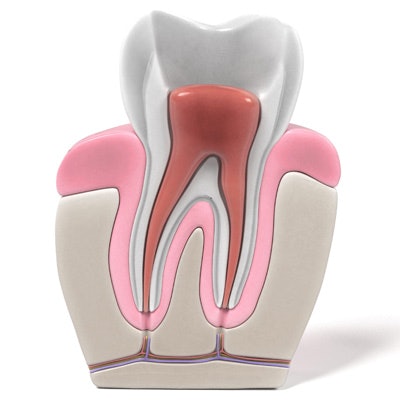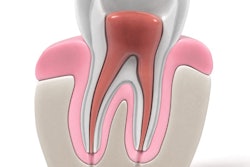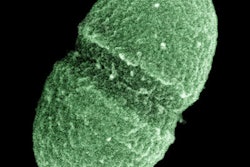
No shaping file system completely removes root canal filling material during retreatment, but passive ultrasonic irrigation and other treatments may be helpful. To learn more about the best devices for this task, researchers compared retreatment with two shaping file systems and two irrigation devices in extracted molars.
After preparation and obturation, researchers retreated the teeth with either the Reciproc R25 instrument (VDW) or the TS2 file of 2Shape (Micro-Mega), then further treated these teeth with one of two passive ultrasonic irrigation systems. While one of the filing systems performed better at removing gutta-percha and sealer, each of the irrigation devices produced similar further improvement, they found.
"A combination of TS2 and passive ultrasonic irrigation leads to fewer remnants in the whole canal," wrote the study authors, led by Dr. Marc Krikor Kaloustian of the department of endodontics at Saint Joseph University in Beirut (Dentistry Journal, January 2019, Vol. 7:1, p. 2).
Getting it out
Root canal retreatment is frequently successful, with nonsurgical retreatment the first option, the authors noted. However, complete elimination of the original root canal filling material is vital.
One previous study found that Reciproc reciprocating movement tools initially designed for shaping procedures work well for removing filling during retreatment, although total elimination of filling material has not been reported with any file system. Some research has suggested the use of passive ultrasonic irrigation for removing the remaining material, although such studies have not been definitive.
“A combination of TS2 and passive ultrasonic irrigation leads to fewer remnants in the whole canal.”
With these findings in mind, the researchers compared the use of the Reciproc R25 instrument with the TS2 file of 2Shape, a continuous rotation shaping system introduced in 2017, for removal of gutta-percha and sealer from the mesial canals of 88 extracted mandibular molars. They knew of no published studies on retreatment with either of the 2Shape files, TS1 or TS2, which has a 25 tip and 6% taper.
The canals were then cleaned with either the Irrisafe (Acteon Group) or EndoUltra (Vista Dental Products) passive ultrasonic irrigation devices to determine if they removed additional debris and if there were differences between the two.
An endodontic specialist shaped the mesial canals with the ProTaper Gold rotary system (Dentsply Sirona) and obturated them. The researchers stored the teeth for 14 days for the sealer to set. Before retreatment, each tooth underwent imaging with a micro-CT scanner (Quantum FX, PerkinElmer).
The researchers randomized half of the teeth (n = 44) to treatment with TS2 and half (n = 44) to R25. The endodontist used TS2 on an MM control motor (Micro-Mega) at 300 rotations per minute (rpm) and 2.5 Newtons per centimeter (N/cm) in a pecking and brushing motion with an amplitude of 3 mm and also used R25 on a VDW Silver Reciproc motor with the same motion type and amplitude.
The researchers considered retreatment complete when working length was reached with no residual filling material detected on the root canal walls under 16x magnification with a clinical microscope or on the flutes of the instruments. Following retreatment, they scanned the roots with micro-CT to determine the volume and percentage of filling material remnants in the coronal, middle, and apical thirds.
Then half of each group (n = 22) underwent further retreatment with either Irrisafe (20/0.02) or EndoUltra (20/0.02), after which they underwent a third micro-CT scan.
TS2 removed 94.75% of the filling material (p < 0.001) compared with the R25 removing 89.3% of the filling material (p < 0.001), with a significant difference between these groups (p = 0.018). Among the TS2 teeth, EndoUltra further decreased residual filling material volume by 0.76% (p < 0.001) and Irrisafe by 1.47% (p < 0.001). In the R25 groups, EndoUltra reduced the volume by 2.61% (p < 0.001) and Irrisafe by 1.66% (p < 0.001). The difference between the four groups in reducing filling material volume was not significant, according to the researchers.
 Reconstructed 3D micro-CT images and cross-sections for groups TS2 with EndoUltra, TS2 with Irrisafe, R25 with EndoUltra, and R25 with Irrisafe, including initial material (IM), residual material (RM1), and the residual material after passive ultrasonic activation (RM2), with the corresponding technique. Image courtesy of Kaloustian et al, "Evaluation of two shaping systems and two ultrasonic irrigation devices in removing root canal rilling material from mesial roots of mandibular molars: A micro-CT study, Dentistry Journal, January 2019, Vol. 7:1, p. 2.
Reconstructed 3D micro-CT images and cross-sections for groups TS2 with EndoUltra, TS2 with Irrisafe, R25 with EndoUltra, and R25 with Irrisafe, including initial material (IM), residual material (RM1), and the residual material after passive ultrasonic activation (RM2), with the corresponding technique. Image courtesy of Kaloustian et al, "Evaluation of two shaping systems and two ultrasonic irrigation devices in removing root canal rilling material from mesial roots of mandibular molars: A micro-CT study, Dentistry Journal, January 2019, Vol. 7:1, p. 2.The combination of TS2 and passive ultrasonic irrigation may have led to fewer remnants being left in the canal because less residual material remained after the use of TS2, the researchers noted.
"Therefore, less contact could have occurred between the ultrasonic tip and the canal walls, allowing its free vibration and the removal of the residual filling material," they wrote.
Ultrasonic irrigation
One limitation of the study was its in vitro design, and the researchers recommended additional studies to confirm the results and find the best combination of instrumentation and passive ultrasonic irrigation for filling removal during retreatment.
"TS2 retreatment is more effective than the R25 retreatment in eliminating gutta-percha and sealer," the authors concluded. "The supplementary approach with the use of passive ultrasonic irrigation significantly improved filling material removal without a statistically significant difference between the Irrisafe and EndoUltra devices."



















